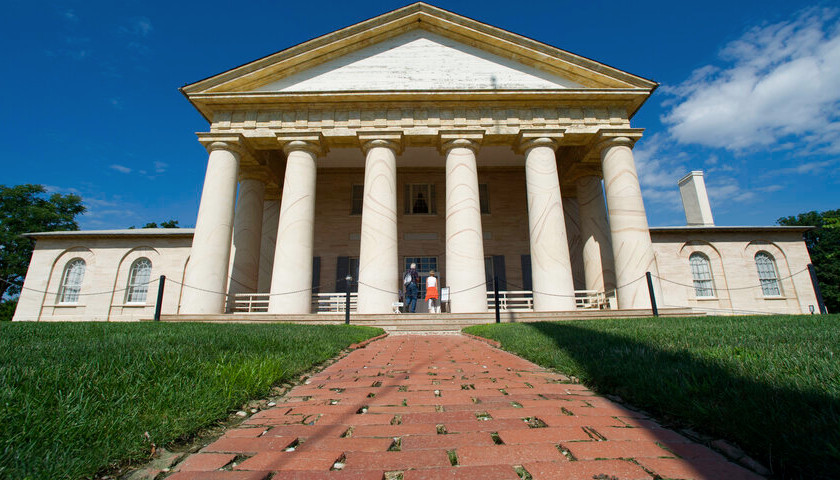by Matthew Barakat
FALLS CHURCH, Virginia (AP) — A northern Virginia congressman is pursuing legislation to remove Confederate Gen. Robert E. Lee’s name from the official designation at the historic mansion where he lived before the Civil War.
The home, overlooking the nation’s capital and surrounded by Arlington National Cemetery, is a National Park Service site officially known as “Arlington House, The Robert E. Lee Memorial.”
Congress renamed the site in 1972 to add Lee’s name and designate it as a memorial to him.
But Democratic Rep. Don Beyer, whose district is home to Arlington House, said it’s time that Lee’s name be stripped.
“Part of the reckoning with the history of racism and slavery in America and in our own community has been a reexamination of public symbols,” Beyer said in a statement to The Associated Press.
Beyer’s plans for legislation comes as descendants of a family enslaved at Arlington House have been lobbying for a name change.
In addition, David Rubenstein, who donated $12 million to support restoration efforts there, said in June that he believes Lee’s name should be removed.
The site itself has been closed for renovations and is expected to reopen later this year.
Beyer, in his statement, cited the requests from descendants of the enslaved as part of his rationale for pursuing the change. He also cited the mansion’s history, noting that “(t)he choice of Lee’s home for the site of a national military cemetery was intended to be a punitive measure against Lee, who himself said after the Civil War that he opposed erecting Confederate monuments.”
The mansion’s history is fascinating and complex. It sits atop a bluff overlooking the Potomac River, with an unparalleled view of Washington. Surrounding the mansion is Arlington National Cemetery, which draws nearly 4 million visitors a year.
It was built by George Washington’s adoptive grandson, George Washington Parke Custis, who maintained the mansion as something of a shrine to Washington.
Custis’ daughter later married Robert E. Lee; they were wed at the home, and Lee managed the property for a number of years before the Civil War.
When the war began, Lee’s family fled the home and Union commanders seized the property. They soon chose to use the land as a burial site for Union soldiers, planting the seeds for Arlington National Cemetery while also rendering the site forever inhospitable to the Lee family as a home.
The debate over Lee’s name at Arlington House comes as Confederate monuments and markers are being reconsidered across the South. In neighboring Fairfax County, the school board recently voted to rename Robert E. Lee High School for the late congressman John Lewis. In Richmond, the state is battling in court for authority to remove a century-old statue of Lee that long anchored the city’s famed Monument Avenue. And in Congress, Beyer and others are seeking to remove statues of Lee and other Confederate figures from the U.S. Capitol.
Craig Syphax of Arlington is one of the descendants of Arlington House slaves who requested Beyer take action. The Syphax family traces its roots to both Mount Vernon and Arlington House. In 1821, Charles Syphax married Maria Carter in a ceremony at Arlington House. It is now generally acknowledged that the unusual honor granted to that slave wedding is because Maria Carter was the illegitimate daughter of Parke Custis and a slave named Arianna Carter. Parke Custis later granted freedom to Maria Syphax and her children, and set aside 17 acres on the property for her family to live. Generations of Syphaxes achieved prominence in a variety of fields.
Craig Syphax said Lee’s name should be removed not only because his contributions to history were negative, but because it overstates Lee’s importance to the history of the site.
“He’s not the headliner for all the history that’s occurred there,” Syphax said. “To the degree that he is a headliner, he’s a headliner for all the wrong reasons.”
Another Syphax descendant, Tracey Syphax of Trenton, New Jersey, said he knew nothing about his family history growing up.
He said learning his family history in his adult years helped give him a new outlook on life. To the degree Arlington House is able to tell its full story, rather than narrowly focusing on Lee, he thinks it can help all Americans have a new outlook on our shared history.
“We all get to a better place if we start telling the true history of America,” he said.
– – –
Matthew Barakat is a reporter for The Associated Press.
About the Headline Photo: In this July 17, 2014, file photo, the historic Arlington House mansion is seen at Arlington National Cemetery in Arlington, Va. A northern Virginia congressman is pursuing legislation to remove Confederate Gen. Robert E.Lee’s name from the official designation of the historic mansion where he lived before the Civil War. The home, overlooking the nation’s capital and surrounded by Arlington National Cemetery, is a National Park Service site officially known as “Arlington House, The Robert E. Lee Memorial.” (AP Photo/Cliff Owen, File)




